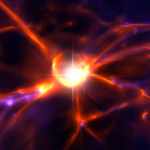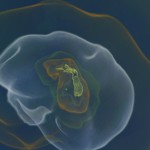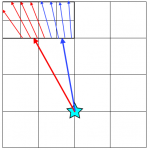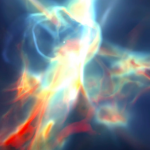The first stars: formation and feedback
 Big Bang nucleosynthesis only produced hydrogen and helium with a trace amount of lithium. Every other element in the present day were created within stars and their supernova explosions. However, what were the properties of the first generation stars in the universe? What were the impacts (aka “feedback”) on their surroundings? Read more…
Big Bang nucleosynthesis only produced hydrogen and helium with a trace amount of lithium. Every other element in the present day were created within stars and their supernova explosions. However, what were the properties of the first generation stars in the universe? What were the impacts (aka “feedback”) on their surroundings? Read more…
Dwarf galaxy formation and evolution
 The feedback from the first stars induce a 10-50 million year delay in star formation in the growing dark matter halo. However once the halo accretes enough dark matter and baryonic mass to effectively cool, and thus condense to high densities, star formation can once again commence. Read more…
The feedback from the first stars induce a 10-50 million year delay in star formation in the growing dark matter halo. However once the halo accretes enough dark matter and baryonic mass to effectively cool, and thus condense to high densities, star formation can once again commence. Read more…
Black hole growth in the early universe
 Distant observations of the most luminous quasars have determined that they are powered by supermassive black holes on the order of 109 solar masses when the universe was only 800 million years old. Two feasible types of seed black holes are the stellar remnants left by Population III stars, which are ~100 solar masses, and a direct gaseous collapse into a 105 solar mass black hole. Read more…
Distant observations of the most luminous quasars have determined that they are powered by supermassive black holes on the order of 109 solar masses when the universe was only 800 million years old. Two feasible types of seed black holes are the stellar remnants left by Population III stars, which are ~100 solar masses, and a direct gaseous collapse into a 105 solar mass black hole. Read more…
Radiation transport
 Radiation from stars and black holes strongly affects their surroundings and plays a crucial role in topics such as stellar atmospheres, the interstellar medium, star formation, galaxy formation, supernovae, and cosmology. Read more…
Radiation from stars and black holes strongly affects their surroundings and plays a crucial role in topics such as stellar atmospheres, the interstellar medium, star formation, galaxy formation, supernovae, and cosmology. Read more…
Photo-realistic visualization
 Most astronomical observations are conducted through the detection of electromagnetic waves from distant objects. To make a direct link between simulations and observations, it is beneficial to construct photo-realistic visualizations of the data. This relates to the topic of radiation transport through the computation of the emission and absorption features in astronomical objects. Read more…
Most astronomical observations are conducted through the detection of electromagnetic waves from distant objects. To make a direct link between simulations and observations, it is beneficial to construct photo-realistic visualizations of the data. This relates to the topic of radiation transport through the computation of the emission and absorption features in astronomical objects. Read more…